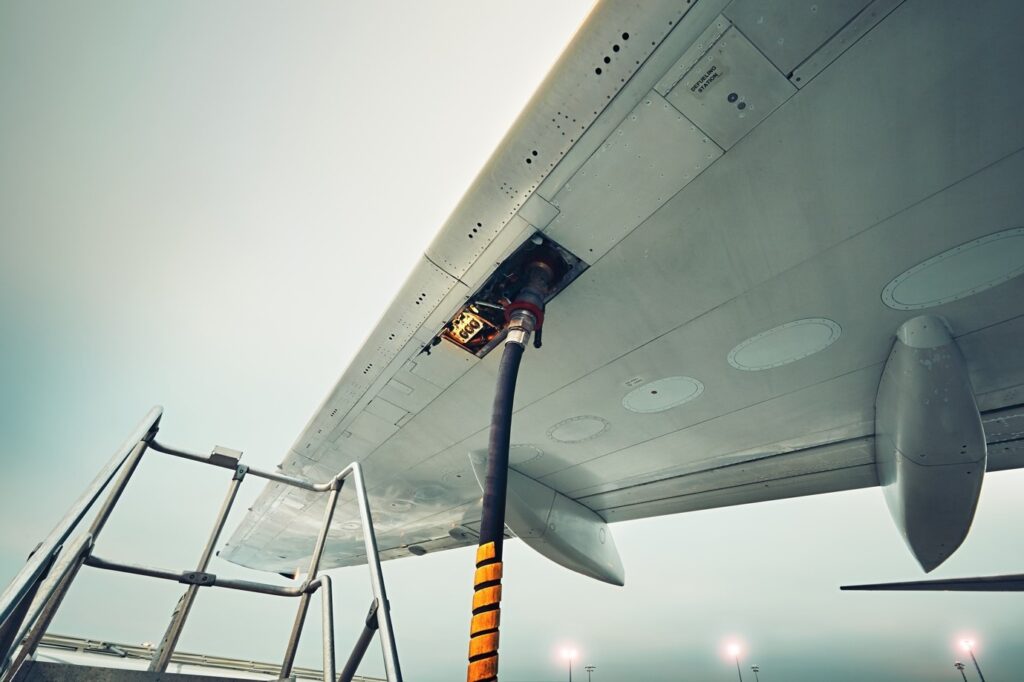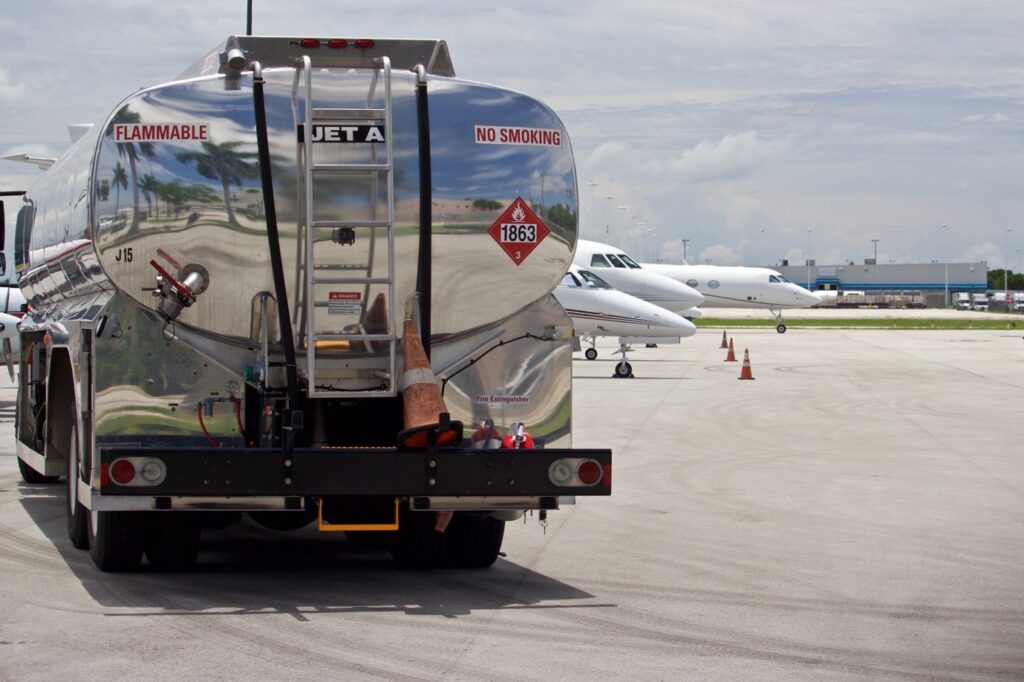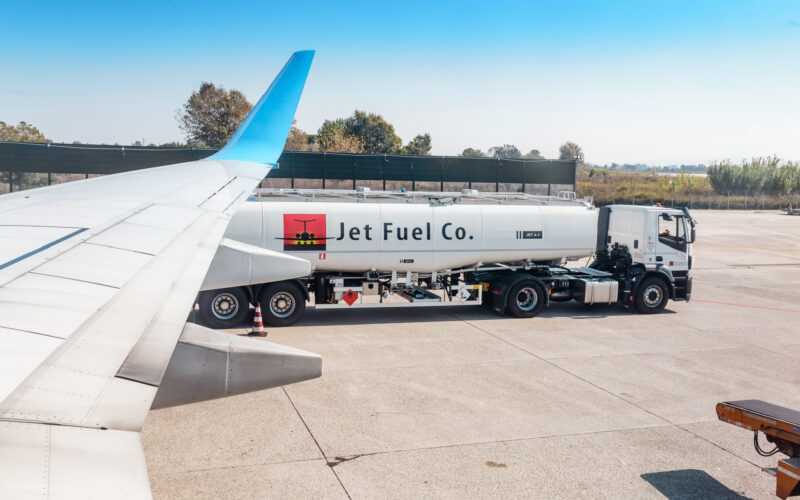Jet fuel plays a key role in aviation, powering aircraft engines and facilitating efficient air travel.
Let’s delve into the history, composition and different types of jet fuel, and explore how it differs from gasoline. We’ll also examine the future of sustainable jet fuel, including biofuels.
History of jet fuel
The development of jet fuel dates back to the early days of aviation. In the 1930s, as jet engines were introduced, the need for specialized fuel arose. Initially, aviation gasoline (AVGAS) was used, but it lacked the necessary properties to meet the demands of jet engines.
The first true jet fuel was called Jet A. Introduced in the 1950s, it’s a kerosene-based fuel specifically designed to meet the requirements of jet engines.

What is jet fuel and what is AVGAS?
Jet fuel is a specialized type of fuel designed to power jet and turbine engines. It is a highly refined, kerosene-based colorless liquid fuel with specific properties to ensure optimal engine performance.
AVGAS refers to aviation gasoline used in piston-engine and propeller aircraft.
How is jet fuel different from gasoline?
Jet fuel and gasoline vary in composition, volatility and energy content. While gasoline primarily consists of hydrocarbons derived from crude oil, jet fuel undergoes a more extensive refining process. Jet fuel has a higher flash point and lower volatility compared to gasoline. It undergoes the process of condensation at a temperature of 180 °C, while AVGAS condenses at a lower temperature of 110 °C. Jet fuel also tends to be less expensive than AVGAS.
Additionally, jet fuel contains specific additives to enhance its performance under extreme temperatures and altitudes. These additives can improve lubricity, prevent corrosion, inhibit icing and enhance thermal stability. Common additives include anti-icing agents, corrosion inhibitors, metal deactivators and antioxidants.
Jet fuel types
Jet A and Jet A-1
Jet A and Jet A-1 are the most common jet fuel types used in commercial aviation. A-1 is mostly used for turbine-engine aircraft. They have similar properties and are widely available globally. These fuels have low freezing points, making them suitable for operations in colder climates.
However, there are some differences between the two. Jet A-1 fuel is formulated with additional anti-static additives to minimize the risk of static electricity buildup during fueling operations. Additionally, Jet A-1 has a lower freezing point of approximately -47°C (-53°F), which makes it well-suited for long-haul international flights and operations in colder climates.
While both Jet A and Jet A-1 are widely used jet fuel types, Jet A is generally more prevalent, especially in the United States and Canada. Jet A-1 is primarily used in Europe, Asia, and other regions outside of North America.

Jet B
Jet B is a blend of kerosene (30%) and gasoline (70%), designed to offer enhanced cold-weather performance. It is primarily used in Arctic regions and has a low freezing point of -60°C.
In addition, it incorporates a corrosion inhibitor that imparts resistance to both heat and water. Nevertheless, due to its highly flammable nature and associated hazards, it is rarely used outside cold climate countries.
JP-5
JP-5 is a type of military jet fuel specifically formulated for use by the United States Navy. It has a high flashpoint that reduces the risk of fire. This kerosene-based fuel is primarily designed for use in aircraft carriers, amphibious assault ships, and other naval aviation platforms.
JP-8
JP-8 is also a type of military jet fuel widely used by various branches of the United States military and NATO. It consists of a blend of approximately 30% kerosene and 70% gasoline and its freezing point can be as low as -60 °C, making it particularly useful in extremely cold regions like Canada and Alaska.
TS-1
TS-1, also known as T-1, is a Russian jet fuel equivalent to Jet A-1, meeting specific regional requirements. With a minimum freeze point of -50°C, the TS-1 fuel is essential for aircraft operations in extremely cold environments. Additionally, the TS-1 exhibits a flash point of 28°C, making the combustion process less safe.
The future of more sustainable jet fuel
Biofuels hold much promise as a sustainable alternative to conventional jet fuels. Biojet fuels, derived from renewable sources such as vegetable oils, algae or agricultural waste, offer the potential to significantly reduce greenhouse gas emissions and dependence on fossil fuels. These biofuels can be produced through processes such as esterification or hydroprocessing.
Biojet fuels have already been successfully tested and used in commercial aviation. They have the advantage of being drop-in fuels, meaning they can be used without significant modifications to existing aircraft or infrastructure. This makes them a viable option for transitioning towards more sustainable aviation.
Several airlines, including British Airways and Virgin Australia as well as industry stakeholders, have initiated projects and collaborations to explore and promote the use of biojet fuels. Sustainable Aviation Fuel (SAF) initiatives have gained momentum globally, with targets set to increase the percentage of biojet fuels in aviation fuel blends.
However, there are still major challenges involved in scaling up the production of biojet fuels and ensuring their cost-effectiveness. The availability of feedstocks, the development of efficient conversion technologies, and the establishment of sustainable supply chains are areas that require continued focus and innovation.
Moreover, ongoing research aims to explore advanced technologies, such as electrofuels (synthetic fuels) and hydrogen-based fuels, which have the potential to further enhance the sustainability and efficiency of aviation fuels.
Hydrogen can be produced from a range of locally accessible sources, including natural gas, nuclear power, biofuels, and renewable energy sources like wind and solar power. Synthetic fuels are produced through various processes, such as Fischer-Tropsch synthesis or the hydrotreating of biomass or waste feedstocks.

